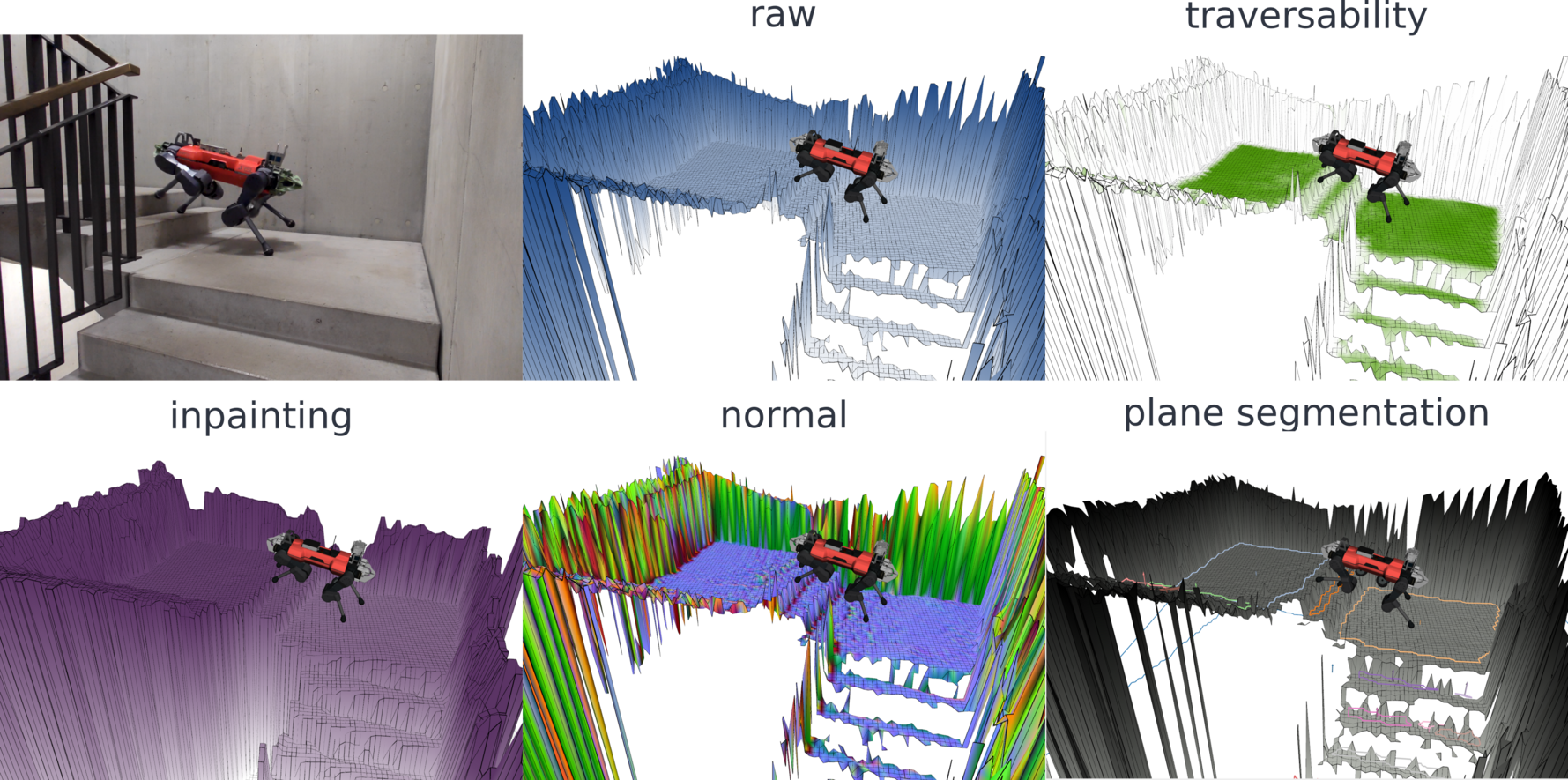Elevation Mapping cupy
Overview
This is a ros package of elevation mapping on GPU.
Code are written in python and uses cupy for GPU calculation.

* plane segmentation is coming soon.
Citing
Takahiro Miki, Lorenz Wellhausen, Ruben Grandia, Fabian Jenelten, Timon Homberger, Marco Hutter
Elevation Mapping for Locomotion and Navigation using GPU arXiv
@misc{https://doi.org/10.48550/arxiv.2204.12876,
doi = {10.48550/ARXIV.2204.12876},
url = {https://arxiv.org/abs/2204.12876},
author = {Miki, Takahiro and Wellhausen, Lorenz and Grandia, Ruben and Jenelten, Fabian and Homberger, Timon and Hutter, Marco},
keywords = {Robotics (cs.RO), FOS: Computer and information sciences, FOS: Computer and information sciences},
title = {Elevation Mapping for Locomotion and Navigation using GPU},
publisher = {arXiv},
year = {2022},
copyright = {arXiv.org perpetual, non-exclusive license}
}
Installation
CUDA & cuDNN
The tested versions are CUDA10.2, 11.6
Check how to install here.
Python dependencies
You will need
For traversability filter, either of
Optinally, opencv for inpainting filter.
Install numpy, scipy, shapely, opencv-python with the following command.
pip3 install -r requirements.txtCupy
cupy can be installed with specific CUDA versions. (On jetson, only "from source" i.e. pip install cupy could work)
For CUDA 10.2 pip install cupy-cuda102
For CUDA 11.0 pip install cupy-cuda110
For CUDA 11.1 pip install cupy-cuda111
For CUDA 11.2 pip install cupy-cuda112
For CUDA 11.3 pip install cupy-cuda113
For CUDA 11.4 pip install cupy-cuda114
For CUDA 11.5 pip install cupy-cuda115
For CUDA 11.6 pip install cupy-cuda116
(Install CuPy from source) % pip install cupy
Traversability filter
You can choose either pytorch, or chainer to run the CNN based traversability filter.
Install by following the official documents.
Pytorch uses ~2GB more GPU memory than Chainer, but runs a bit faster.
Use parameter use_chainer to select which backend to use.
ROS package dependencies
sudo apt install ros-noetic-pybind11-catkin
sudo apt install ros-noetic-grid-map-core ros-noetic-grid-map-msgsOn Jetson
CUDA CuDNN
CUDA and cuDNN can be installed via apt. It comes with nvidia-jetpack. The tested version is jetpack 4.5 with L4T 32.5.0.
python dependencies
On jetson, you need the version for its CPU arch:
wget https://nvidia.box.com/shared/static/p57jwntv436lfrd78inwl7iml6p13fzh.whl -O torch-1.8.0-cp36-cp36m-linux_aarch64.whl
pip3 install Cython
pip3 install numpy==1.19.5 torch-1.8.0-cp36-cp36m-linux_aarch64.whlAlso, you need to install cupy with
pip3 install cupyThis builds the packages from source so it would take time.
ROS dependencies
sudo apt install ros-melodic-pybind11-catkin
sudo apt install ros-melodic-grid-map-core ros-melodic-grid-map-msgsAlso, on jetson you need fortran (should already be installed).
sudo apt install gfortranIf the Jetson is set up with Jetpack 4.5 with ROS Melodic the following package is additionally required:
git clone git@github.com:ros/filters.git -b noetic-develUsage
Build
catkin build elevation_mapping_cupyErrors
If you get error such as
Make Error at /usr/share/cmake-3.16/Modules/FindPackageHandleStandardArgs.cmake:146 (message):
Could NOT find PythonInterp: Found unsuitable version "2.7.18", but
required is at least "3" (found /usr/bin/python)
Build with option.
catkin build elevation_mapping_cupy -DPYTHON_EXECUTABLE=$(which python3)Run
Basic usage.
roslaunch elevation_mapping_cupy elevation_mapping_cupy.launchRun TurtleBot example
First, install turtlebot simulation.
sudo apt install ros-noetic-turtlebot3*Then, you can run the example.
export TURTLEBOT3_MODEL=waffle
roslaunch elevation_mapping_cupy turtlesim_example.launchTo control the robot with a keyboard, a new terminal window needs to be opened.
Then run
export TURTLEBOT3_MODEL=waffle
roslaunch turtlebot3_teleop turtlebot3_teleop_key.launchVelocity inputs can be sent to the robot by pressing the keys a, w, d, x. To stop the robot completely, press s.
Subscribed Topics
-
topics specified in
pointcloud_topicsinparameters.yaml([sensor_msgs/PointCloud2])The distance measurements.
-
/tf([tf/tfMessage])The transformation tree.
Published Topics
The topics are published as set in the rosparam.
You can specify which layers to publish in which fps.
Under publishers, you can specify the topic_name, layers basic_layers and fps.
publishers:
your_topic_name:
layers: ['list_of_layer_names', 'layer1', 'layer2'] # Choose from 'elevation', 'variance', 'traversability', 'time' + plugin layers
basic_layers: ['list of basic layers', 'layer1'] # basic_layers for valid cell computation (e.g. Rviz): Choose a subset of `layers`.
fps: 5.0 # Publish rate. Use smaller value than `map_acquire_fps`.Example setting in config/parameters.yaml.
-
elevation_map_raw([grid_map_msg/GridMap])The entire elevation map.
-
elevation_map_recordable([grid_map_msg/GridMap])The entire elevation map with slower update rate for visualization and logging.
-
elevation_map_filter([grid_map_msg/GridMap])The filtered maps using plugins.
Plugins
You can create your own plugin to process the elevation map and publish as a layer in GridMap message.
Let's look at the example.
First, create your plugin file in elevation_mapping_cupy/script/plugins/ and save as example.py.
import cupy as cp
from typing import List
from .plugin_manager import PluginBase
class NameOfYourPlugin(PluginBase):
def __init__(self, add_value:float=1.0, **kwargs):
super().__init__()
self.add_value = float(add_value)
def __call__(self, elevation_map: cp.ndarray, layer_names: List[str],
plugin_layers: cp.ndarray, plugin_layer_names: List[str])->cp.ndarray:
# Process maps here
# You can also use the other plugin's data through plugin_layers.
new_elevation = elevation_map[0] + self.add_value
return new_elevationThen, add your plugin setting to config/plugin_config.yaml
example: # Use the same name as your file name.
enable: True # weather to laod this plugin
fill_nan: True # Fill nans to invalid cells of elevation layer.
is_height_layer: True # If this is a height layer (such as elevation) or not (such as traversability)
layer_name: "example_layer" # The layer name.
extra_params: # This params are passed to the plugin class on initialization.
add_value: 2.0 # Example paramFinally, add your layer name to publishers in config/parameters.yaml.
You can create a new topic or add to existing topics.
plugin_example: # Topic name
layers: ['elevation', 'example_layer']
basic_layers: ['example_layer']
fps: 1.0 # The plugin is called with this fps.